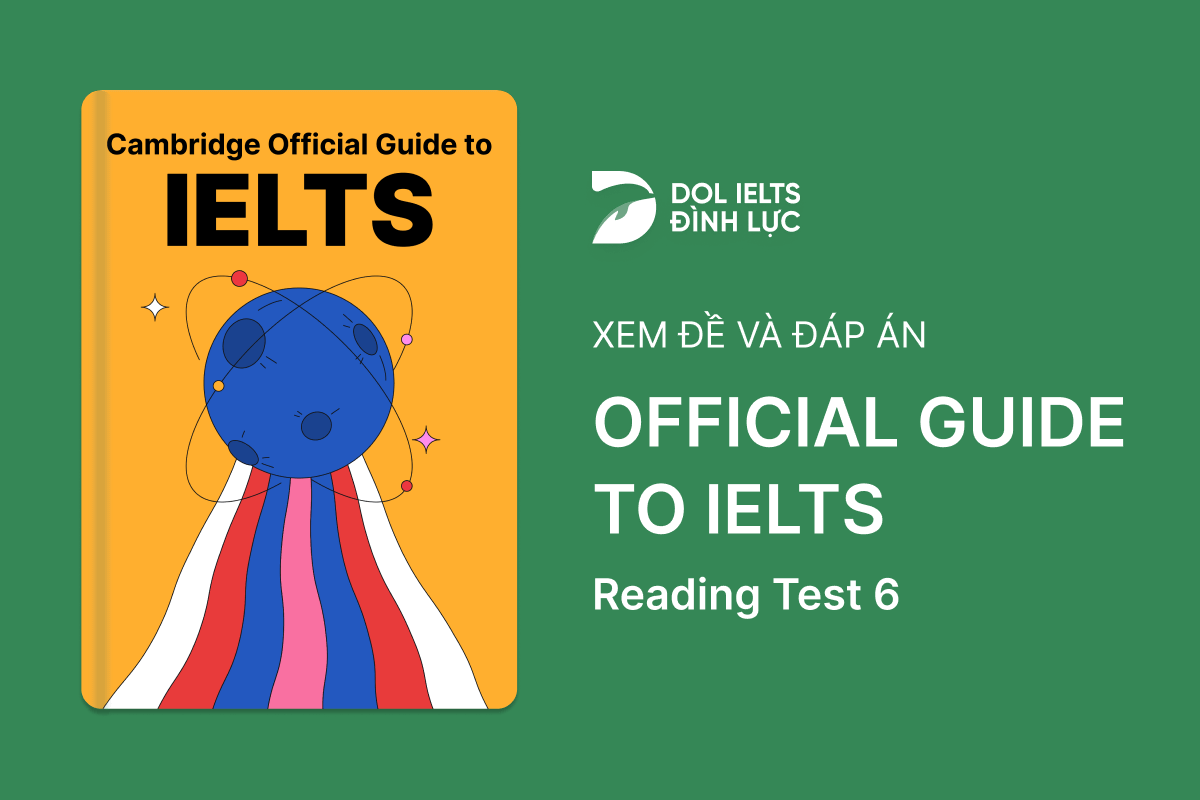Official Cambridge Guide To IELTS - Reading Test 6 With Practice Test, Answers And Explanation
Luyện tập đề IELTS Online Test Official Cambridge Guide To IELTS - Reading Test 6 được lấy từ cuốn sách Official Cambridge Guide To IELTS với trải nghiệm thi IELTS trên máy và giải thích đáp án chi tiết bằng Linearthinking, kèm answer key và list từ vựng IELTS cần học trong bài đọc.
Passage
📖 Bài đọc passage 1
❓ Câu hỏi passage 1
🔥 Đáp án & giải thích 1
Giải thích chi tiết
Skimming/ scanning 
Nếu chỉ skim/scan từ khoá giống nhau giữa đoạn văn và list of headings, thí sinh rất dễ bị rối vì dường như heading nào cũng na ná nhau, cũng nhắc tới “education" => Không biết phải chọn heading nào.
Nếu chỉ skim/scan từ khoá giống nhau giữa đoạn văn và list of headings, thí sinh rất dễ bị rối vì dường như heading nào cũng na ná nhau, cũng nhắc tới “education" => Không biết phải chọn heading nào.
i A business-model approach to education
ii The reforms that improved education in Finland
iii Educational challenges of the future
iv Ways in which equality is maintained in the Finnish education system
Passage
📖 Bài đọc passage 2
❓ Câu hỏi passage 2
🔥 Đáp án & giải thích 2
Giải thích chi tiết
Skimming/ scanning 
Nếu chỉ skim/scan từ khoá giống nhau giữa đoạn văn và list of headings, thí sinh rất dễ chọn những heading như:
iv Variations in alcohol content
Thí sinh dễ chọn heading này vì thấy cụm “alcoholic substance" rất giống với “alcohol content" trong heading.
Tuy nhiên, không chọn được heading này vì heading đề cập tới “variations" (sự đa dạng, khác biệt) trong thành phần alcohol, nhưng đoạn này lại chẳng đi sâu vào alcohol hay thành phần của nó, mà chỉ đề cập tới alcohol trong đúng 1 cụm mà thôi.
x Ways to improve taste
Một vài thí sinh hay chọn nhầm câu này vì thấy từ “tasty" xuất hiện trong câu cuối cùng của đoạn. Tuy nhiên, câu này vẫn chưa phải đáp án đúng. (Muốn biết tại sao chưa đúng thì cùng nhìn thử bài giải bằng Linearthinking nhé)
Linearthinking
Nếu chỉ skim/scan từ khoá giống nhau giữa đoạn văn và list of headings, thí sinh rất dễ chọn những heading như:
iv Variations in alcohol content
Thí sinh dễ chọn heading này vì thấy cụm “alcoholic substance" rất giống với “alcohol content" trong heading.
Tuy nhiên, không chọn được heading này vì heading đề cập tới “variations" (sự đa dạng, khác biệt) trong thành phần alcohol, nhưng đoạn này lại chẳng đi sâu vào alcohol hay thành phần của nó, mà chỉ đề cập tới alcohol trong đúng 1 cụm mà thôi.
x Ways to improve taste
Một vài thí sinh hay chọn nhầm câu này vì thấy từ “tasty" xuất hiện trong câu cuối cùng của đoạn. Tuy nhiên, câu này vẫn chưa phải đáp án đúng. (Muốn biết tại sao chưa đúng thì cùng nhìn thử bài giải bằng Linearthinking nhé)
Linearthinking 
Để làm đúng Matching Heading, cần áp dụng Linearthinking qua hai bước Simplify + Read Connection
Simplify + Read connection
(1) + (2) + (3) The shepherds discovered a new substance while transporting milk.
(4) Nói về tầm quan trọng của new substance (=new drink) này
=> Main idea: Shepherds tình cờ phát hiện new drink khi đang vận chuyển milk và phát hiện này rất quan trọng
Để làm đúng Matching Heading, cần áp dụng Linearthinking qua hai bước Simplify + Read Connection
Simplify + Read connection
(1) + (2) + (3) The shepherds discovered a new substance while transporting milk.
(4) Nói về tầm quan trọng của new substance (=new drink) này
=> Main idea: Shepherds tình cờ phát hiện new drink khi đang vận chuyển milk và phát hiện này rất quan trọng
So với list of heading:
Chọn heading viii. A fortunate accident (Một phát hiện tình cờ may mắn) 
Paraphrasing: Accident (Phát hiện tình cờ) = Discovered a new substance while transporting milk
Fortunate = Tầm quan trọng của phát hiện này (health tonic, dairy product, tasty addition…)
Paraphrasing: Accident (Phát hiện tình cờ) = Discovered a new substance while transporting milk
Fortunate = Tầm quan trọng của phát hiện này (health tonic, dairy product, tasty addition…)
Passage
📖 Bài đọc passage 3
❓ Câu hỏi passage 3
🔥 Đáp án & giải thích 3
Giải thích chi tiết
Skimming/scanning 
Những câu hỏi Multiple Choice thuộc dạng hỏi Main Idea, đòi hỏi học viên phải hiểu mối liên hệ giữa các câu và tóm được nội dung câu chứ không chỉ skim/scan từ khoá. Ví dụ. Nếu chỉ skim/scan mà không nắm được main idea thì học viên rất dễ chọn các đáp án như:
Những câu hỏi Multiple Choice thuộc dạng hỏi Main Idea, đòi hỏi học viên phải hiểu mối liên hệ giữa các câu và tóm được nội dung câu chứ không chỉ skim/scan từ khoá. Ví dụ. Nếu chỉ skim/scan mà không nắm được main idea thì học viên rất dễ chọn các đáp án như:
B Once the idea for it was conceived, it did not take long to develop.
=> Có học viên sẽ chọn câu này vì thấy trong câu 3 trong đoạn có từ “An idea" rất giống với “The idea" trong lựa chọn B. Tuy nhiên, lựa chọn B nói rõ là “When the idea was conceived (= appeared), it did not take long to develop" (khi đã có idea rồi thì phát triển rất nhanh) trong khi bài lại nói rõ ở câu cuối: “Mountains of prototypes and years of teamwork later, they unveiled the Swiffer” = After years of teamwork, they unveiled the Swiffer (phải sau hàng năm trời mới ra được Swiffer"
=> Không thể chọn B.
Linearthinking 


